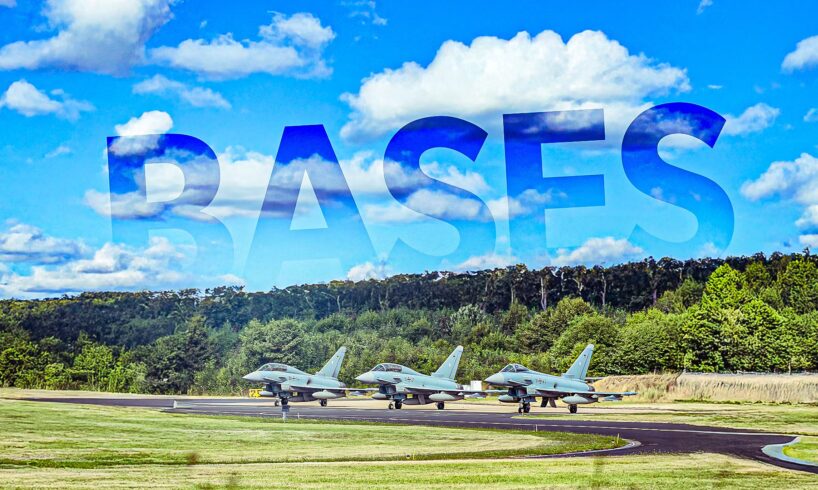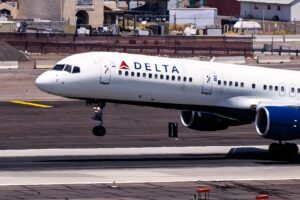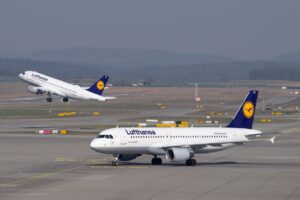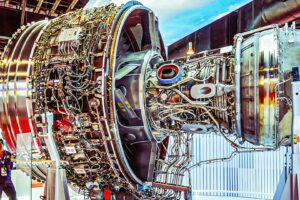
Air bases are far more than runways: they are the logistical keystones of air power. The number, type, and geographic spread of an air force’s bases directly shapes how quickly it can surge aircraft, sustain operations, and respond across time zones, from short-notice air policing to sustained expeditionary campaigns. A dense domestic network buys resilience at home; a broad overseas footprint buys reach and influence abroad.
In this guide, we chart the world’s largest air forces by number of bases, counting permanent domestic fields as well as overseas, joint and dual-use installations where public data shows a regular aviation presence. That means we treat a permanent US installation in Germany or Japan, a Chinese runway upgrade on a South China Sea outpost, and an Indian forward air station in Ladakh as comparable nodes of capability, while also flagging differences in quality, readiness, and permanence. For global comparison and aggregate force posture, the IISS Military Balance and official DoD/defense ministry reports are primary reference points.
Why Base Networks Matter: Power, Presence, And Resilience
Credit: USAF
Air bases are the physical expression of a nation’s reach. A broad, resilient network gives commanders the freedom to launch, resupply, or redeploy aircraft without being bottlenecked by distance. In the language of airpower, this is known as “positional advantage”, the ability to project force faster and farther than an adversary.
Strategically, having many bases translates to options. The United States Air Force can strike targets on multiple continents because it maintains a global chain of hubs, from Ramstein Air Base in Germany to Andersen in Guam , each one stocked with fuel, spare parts, and communications infrastructure.
China’s People’s Liberation Army Air Force (PLAAF) has studied this model closely, expanding its own “strategic support points” in the South China Sea and Africa to support longer-range bomber patrols. For middle powers like France or Japan , maintaining even a handful of overseas airfields, such as Djibouti or Naha, allows global engagement far beyond their borders.
In a high-threat environment, base networks are just as important for survival as for power projection. Dispersed operations, spreading aircraft across multiple smaller or temporary airfields, make it harder for an enemy to disable an entire fleet in a single strike. This idea is now central to Western air doctrine.
The US Air Force’s Agile Combat Employment (ACE) concept, for example, trains crews to operate from improvised locations with minimal infrastructure, using a “hub-and-spoke” system across the Pacific.
NATO allies are adopting similar tactics, emphasizing road runways, camouflaged hangars, and mobile fuel trucks: lessons drawn from Cold War-era dispersal strategies. Yet base count alone doesn’t equal power. A nation may have dozens of airfields, but lack the logistical throughput of the fuel, munitions, maintenance facilities, and trained personnel to keep them operational under stress. As every planner knows, logistics win wars. Fuel bowsers, spare engines, ground crews, and runways form the arteries to keep airpower alive.
In Ukraine and the Red Sea, recent conflicts have underscored that sustaining sorties over weeks depends less on the number of aircraft and more on where they can land, rearm, and recover. As strategic competition intensifies, nations are rediscovering the importance of basing resilience.
The United States is upgrading Pacific sites such as Tinian and Palau; China is hardening its western and maritime bases; and NATO is reopening Soviet-era airfields in Poland and the Baltics. In this new era, the “base map” of the world is being redrawn, not as static real estate, but as a dynamic web of access, partnerships, and survivable operating locations.
The United States: The Gold Standard In Global Basing
Credit: Photo: US Air Force
The US operates one of the densest base networks in the world: hundreds of domestic airfields plus more than 120 overseas locations as of 2024. According to a US Congressional Research Service report, the Department of Defense manages or uses at least 128 overseas bases across 51 countries.
Within the United States, the Air Force, Navy, and Marine Corps collectively maintain several hundred installations, ranging from major operational hubs to specialized test ranges. These domestic bases, some of them located in really extreme areas, are crucial for training, logistics, maintenance, and rapid mobilization. Examples include:
Nellis Air Force Base (Nevada) serves as the nation’s premier hub for advanced aerial combat training, operational testing, and large-scale exercises such as the Red Flag.
Naval Station Norfolk (Virginia) anchors the US Navy’s Atlantic Fleet and stands as the largest naval base in the world, supporting both carrier strike groups and air operations.
Marine Corps Base Camp Pendleton (California) functions as the primary amphibious and expeditionary training center for the Marine Corps, preparing forces for rapid global deployment.
Abroad, a network of strategically positioned installations underpins America’s forward military posture. Some of the most prominent include:
Ramstein Air Base, Germany: acts as the central hub for US operations across Europe and Africa, enabling logistics coordination, aerial refueling, and medical evacuation support.
Kadena Air Base, Japan: critical for the US Indo-Pacific presence and vital to regional deterrence, hosting a wide range of fighter, reconnaissance, and support aircraft.
Al Udeid Air Base, Qatar: serves as a forward command and control center for air operations throughout the Middle East.
Andersen Air Force Base, Guam: provides the US Air Force with an enduring platform for long-range bomber and surveillance missions across the Pacific theater .
These installations enable a unique combination of strategic reach, logistical depth, and rapid-response capability, covering Europe, the Middle East, Africa, and the Indo-Pacific.
This global bases network underscores why the US is often considered the gold standard in military forward deployment: unrivaled geographic coverage combined with operational flexibility.
Russia And China: Legacy And Expansion
Credit: Wikimedia Commons
Russia and China are pursuing very different approaches to military basing, shaped by history, geography, and strategic priorities.
Russia inherited a vast amount of Soviet-era military infrastructure, with dozens of major airbases spanning from Siberia to the Arctic. While some installations have declined in readiness since the Soviet collapse, several remain central to Russia’s airpower:
Engels Air Base: home to Russia’s long-range strategic bombers.
Lipetsk Air Base: a hub for fighter pilot training and advanced aviation exercises.
Severomorsk-1 and other Arctic airfields: enabling operations in the increasingly strategic Arctic region.
Many smaller bases are maintained at lower readiness levels but can be activated for surge operations, reflecting a mix of legacy infrastructure and modernized facilities.
China, meanwhile, is aggressively expanding and upgrading its airbase network, with a growing emphasis on projecting power beyond its borders. The US Department of Defense’s China Military Power Report (2023) highlights significant developments across the South China Sea, underscoring Beijing’s determination to secure forward operating positions far from its mainland coast.
On Woody Island in the Paracel chain, China has extended its concrete runway to around 8,858 feet (2,700 metres), alongside new hangars and fuel storage facilities capable of supporting fighter and bomber deployments.
Further south, Fiery Cross Reef in the Spratly Islands has emerged as a heavily fortified aviation hub, with a runway measuring roughly 9,843 to 10,253 feet (3,000 to 3,125 meters) and extensive radar, missile, and logistics infrastructure.
Together, these outposts transform China’s once-limited maritime presence into a network capable of sustained PLAAF and PLAN operations across the broader South China Sea.
In addition, China’s mainland network has been upgraded with modern runways, hardened aircraft shelters, and advanced logistics hubs. While exact numbers are difficult to confirm, estimates suggest China operates over 100 airfields capable of supporting PLAAF operations.
Base / Country
Location / Notes
Runway Length
Primary Aircraft / Capability
Engels-2 (Russia)
Saratov Oblast, Russia’s main strategic bomber base.
11,483 feet / 3,500 meters
Tu-160 and Tu-95MS long-range bombers; nuclear and conventional strike missions.
Lipetsk (Russia)
Lipetsk Oblast, Russia’s premier fighter training and evaluation center.
9,843 feet / 3,000 meters
Su-30SM, Su-35, and MiG-29 are used for advanced pilot training and weapons testing.
Severomorsk-1 (Russia)
Murmansk region, Arctic operations and naval aviation hub.
Approximately 11,483 feet / 3,500 meters
Su-33, Su-25, Il-38. Carrier aviation training and Arctic patrol operations.
Woody Island / Yongxing (China)
Paracel Islands, China’s northern South China Sea outpost.
8,858 feet / 2,700 meters
J-10, J-11, and H-6J aircraft. Forward-deployed air and maritime strike capability.
Fiery Cross Reef / Yongshu (China)
Spratly Islands, the largest and most fortified reclaimed island base.
Approximately 9,843–10,253 feet / 3,000–3,125 meters
J-11, J-15, and H-6 aircraft. Capable of hosting bombers, fighters, and surveillance assets.
These developments underscore a shift in military-based strategy: it is no longer solely about defending national airspace. Instead, both Russia and China are increasingly focused on power projection, rapid regional response, and contested zone influence.
India, Japan, And Regional Powers In Asia-Pacific
Credit: US Air Force
The Asia-Pacific is home to several regional powers with growing air capabilities and increasingly strategic basing networks. Among them, India, Japan, and Australia stand out for their evolving roles in regional security and defense integration.
India operates a robust network of over 60 air stations across its vast territory, supporting both defensive and rapid-response operations. Key forward bases, such as Leh, Thoise, and Jorhat, play vital roles in high-altitude operations along the borders with China and Pakistan .
Beyond these, installations like Ambala, Pune, and Sulur house advanced aircraft such as the Dassault Rafale and Su-30MKI, reinforcing India’s capacity for regional deterrence and expeditionary missions. India’s basing strategy also includes a growing number of dual-use civilian-military airfields to improve flexibility and reach.
The Japan Air Self-Defense Force (JASDF) operates approximately 40 bases across the archipelago. These installations form the backbone of Japan’s air defense and maritime surveillance capabilities.
Key sites include:
Misawa Air Base – hosting both JASDF and US forces for northern defense.
Naha Air Base – positioned close to the Senkaku Islands, critical for southern air defense.
Hyakuri Air Base – near Tokyo, serving as a central hub for fighter operations.
Japan continues to expand or upgrade island facilities, particularly in Okinawa and the Ryukyu chain, to enhance deterrence and response capability amid growing challenges in the East China Sea.
Australia’s Royal Australian Air Force (RAAF) operates about 20 major airbases, reflecting the country’s vast geography and strategic reach. Bases such as RAAF Darwin, Tindal, and Amberley form the core of a northward-oriented strategy, allowing for rapid engagement across the Indo-Pacific.
Recent cooperation with the US and UK under the AUKUS framework further underscores Canberra’s intent to strengthen its forward bases and interoperability. Collectively, these nations demonstrate that airbase networks in the Asia-Pacific are no longer limited to homeland defense. They are increasingly designed for regional integration, long-range operations, and coalition readiness, reinforcing a shared commitment to stability in one of the world’s most dynamic strategic theaters.
Europe And NATO: Shared Infrastructure, Shared Power
Credit: Wikimedia Commons
Europe’s airpower strength lies not in sheer numbers but in collective capability. Through NATO, member states operate a combined network of over 200 air bases, providing depth, flexibility, and interoperability across the continent.
Individually, major NATO members sustain strong domestic basing networks:
United Kingdom – around 30 active bases, including RAF Lossiemouth and RAF Coningsby, key for Typhoon and F-35 operations.
France – approximately 30–35 air bases, hosting Rafale and Mirage fleets as well as nuclear-capable units under the Force Aérienne Stratégique.
Germany – roughly 20 main air bases, such as Büchel and Laage, with a growing emphasis on Eurofighter operations.
Eastern Europe – nations such as Poland, Romania, and the Baltic States have heavily invested in runway and infrastructure upgrades to support rotating allied deployments under NATO’s Enhanced Air Policing mission.
NATO’s collective airpower is amplified by shared platforms and standardized logistics. Notable multinational fleets include:
Multinational MRTT Fleet (MMF) , a pooled fleet of Airbus A330 Multi Role Tanker Transport aircraft based in the Netherlands, available to participating nations.
NATO AWACS Fleet , E-3A aircraft based at Geilenkirchen, Germany, providing long-range air surveillance and command capability.
Alliance Ground Surveillance (AGS), RQ-4D Phoenix drones operating from Sigonella, Italy, enhancing reconnaissance and intelligence-sharing.
These shared capabilities allow smaller air forces to contribute meaningfully to large-scale operations, giving NATO a powerful edge in collective air readiness and rapid-response capacity.
Nation / Region
Approx. Active Air Bases
Key Example Bases
Runway Length
Typical Aircraft / Roles
Approx. Aircraft Capacity
United Kingdom
~30
RAF Lossiemouth, RAF Coningsby
9,000–9,200 feet / 2,740–2,800 meters
Eurofighter Typhoon, F-35B Lightning II – air defence and multirole operations
60–80 combat aircraft (depending on dispersal)
France
30–35
BA 113 Saint-Dizier, BA 118 Mont-de-Marsan
9,800 feet / 3,000 meters
Rafale B/C/M, Mirage 2000 – strike, deterrent, and nuclear-capable missions
50–70 aircraft across wings
Germany
~20
Büchel AB, Laage AB
8,850–9,850 feet / 2,700–3,000 meters
Eurofighter Typhoon, Tornado IDS/ECR – tactical strike and SEAD roles
40–60 aircraft (typical for Luftwaffe wings)
Eastern Europe (Poland, Romania, Baltics)
~15 (modernized)
Łask AB, Câmpia Turzii AB, Šiauliai AB
8,000–9,000 feet / 2,440–2,750 meters
F-16, MiG-29, and rotating NATO detachments – air policing and regional readiness
20–40 aircraft per site under rotation
Multinational NATO Fleets
Operated from 3 primary hubs
Geilenkirchen (E-3A AWACS), Eindhoven (A330 MRTT), Sigonella (RQ-4D Phoenix)
9,000–10,000 feet / 2,740–3,050 meters
AWACS surveillance, tanker, and reconnaissance operations
15–25 multinational aircraft (shared assets)
Europe’s NATO network also serves as a testbed for interoperability. Standardized refueling procedures, shared maintenance protocols, and common aircraft types (such as the F-35A and A330 MRTT) streamline multinational operations. Regular large-scale exercises like Air Defender (Germany) and Atlantic Trident (France/UK/US) validate how this shared infrastructure translates into real-world combat readiness.
This combination of national capability, shared platforms, and coordinated doctrine makes NATO’s air-base structure not just a collection of airfields, but a cohesive system of integrated regional power projection.
The Future: Dispersal, Dual-Use, And Agile Basing
Credit: US Air Force
The military base of tomorrow is moving beyond the traditional concept of fixed, permanent installations. Modern strategies emphasize flexibility, survivability, and rapid deployment. Agile Combat Employment (ACE) envisions forces capable of rapid deployment to austere or temporary airfields, including civilian airports adapted for military operations, forward operating locations with minimal infrastructure, and modular logistics hubs that can be relocated or scaled according to mission needs. This approach allows forces to disperse assets, reduce vulnerability to precision strikes, and maintain operational continuity in contested environments.
As satellites, drones, long-range precision weapons, and hypersonic systems reshape warfare, the future of basing is becoming less about permanent structures and more about interconnected networks of nodes. These nodes can incorporate hardened shelters for aircraft, mobile maintenance and refueling units, and forward-deployed command-and-control elements, providing resilience, unpredictability, and rapid-response capability. Such a networked approach enables militaries to maintain presence across multiple theaters without relying on any single high-value target.
Civilian infrastructure will increasingly support military operations, from commercial runways and ports to logistics centers. Dual-use strategies maximize efficiency while allowing for rapid scaling in times of crisis. Nations like the United States, Japan, and Australia are already experimenting with exercises that test how fighter jets, transport aircraft, and drones can operate from shared civilian-military infrastructure.
This shift toward dispersal, dual-use, and agility represents a fundamental evolution in basing philosophy. Future airpower will rely on mobility, redundancy, and networked resilience, enabling militaries to respond rapidly, operate effectively in contested environments, and survive in the era of long-range precision and multi-domain warfare.






